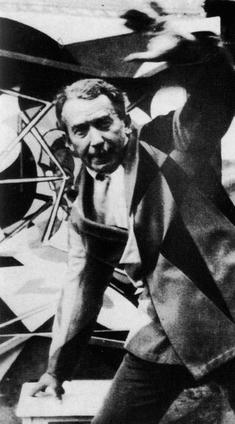Giacomo Balla facts for kids
Quick facts for kids
Giacomo Balla
|
|
|---|---|
 |
|
| Born |
Giacomo Joseph Balla
18 July 1871 Turin, Italy
|
| Died | 1 March 1958 (aged 86) Rome, Italy
|
| Known for | Painting, poetry |
| Movement | Futurism |
Giacomo Balla (born July 18, 1871 – died March 1, 1958) was an Italian painter, art teacher, and poet. He is best known as a very important artist in the Futurism art movement. In his paintings, he loved to show light, movement, and speed.
Balla wanted to express motion in his art. But unlike some other Futurist artists, he was not interested in machines or violence. His works often looked clever and playful instead.
Contents
Biography
Early Life and Art Studies
Giacomo Balla was born in Turin, a city in the Piedmont region of Italy. His father was a photographer, and Giacomo studied music when he was a child.
When he was nine years old, his father passed away. Giacomo stopped studying music and started working in a print shop that made lithographs. By the time he was 20, he loved visual art so much that he decided to study painting. Some of his early paintings were shown in art exhibitions.
After studying at the University of Turin, Balla moved to Rome in 1895. There, he met Elisa Marcucci, and they later got married. For several years, he worked in Rome as an illustrator, drawing funny pictures (caricatures), and painting portraits of people.
Becoming a Futurist Artist
In 1899, Balla's art was shown at the Venice Biennale, a famous art exhibition. In the years that followed, his art was displayed in big shows in Rome and Venice. It was also shown in other cities like Munich, Berlin, Düsseldorf, Paris, and Rotterdam.
Around 1902, Balla taught painting techniques to other artists like Umberto Boccioni and Gino Severini. He taught them a style called Divisionism. This style used small dots or strokes of pure color to create a vibrant effect.
Later, Balla was inspired by Filippo Tommaso Marinetti, who started the Futurism movement. Giacomo Balla then began to paint in the Futurist style. He focused on showing light, movement, and speed in his art. In 1910, he signed the Futurist Manifesto. This was a document that explained the ideas and goals of the Futurist artists.
Some of his most famous Futurist paintings include Dynamism of a Dog on a Leash (1912) and Abstract Speed + Sound (1914). In 1914, he also started designing Futurist furniture. He even designed special Futurist "anti-neutral" clothing. Balla also began to create sculptures. In 1915, he made a well-known sculpture called Boccioni's Fist. This sculpture showed the idea of "lines of force."
Later Life and Legacy
During World War I, Balla's art studio became a popular meeting place for young artists. They would gather there to discuss art and ideas.
In 1935, Giacomo Balla became a member of Rome's Accademia di San Luca. This is a very old and respected art academy. He also took part in a big art exhibition called documenta 1 in Kassel in 1955.
Giacomo Balla passed away on March 1, 1958.
Notable Works
Capturing Light and Movement
Balla's 1909 painting The Street Light is a great example of how he explored light, the feeling of the air, and motion. He wanted to show how light spreads and changes.
His most famous works, like Dynamism of a Dog on a Leash from 1912, try to show movement. They also show the passing of time through painting. One of Balla's main inspirations was chronophotography. This was an early way of taking many photos quickly to show movement, like a flipbook. It was developed by people like Étienne-Jules Marey.
Showing Speed and Sound
Balla's 1912 painting The Hand of the Violinist shows the fast movement of a musician playing a violin. This painting was inspired by Cubism, another art style, and the photography experiments of Marey and Eadweard Muybridge.
In his abstract series from 1912–1914 called Iridescent Interpenetration, Balla tried to separate the experience of light from seeing objects. He focused purely on how colors and light interact.
Abstract Speed + Sound (1913–14) is a study of speed. It uses the image of an automobile to represent how fast things can go. This painting might have been part of a set of three paintings.
Art and Politics
Balla was also a leading artist in the Futurist movement that included fashion. His designs for clothing often had sharp, strong lines of color. They were bold and masculine. Balla designed a special wrap-around garment with strong patterns. These patterns were called ‘force-lines’ and used the red, white, and green colors of the Italian flag. He also designed a matching beret. The goal was to make the person wearing it look like a ‘human flag’. This was meant to encourage Italians to support a strong, nationalist political idea.
See also
- In Spanish: Giacomo Balla para niños
- Works by Giacomo Balla
- Italian Futurism
- Parade (ballet)


